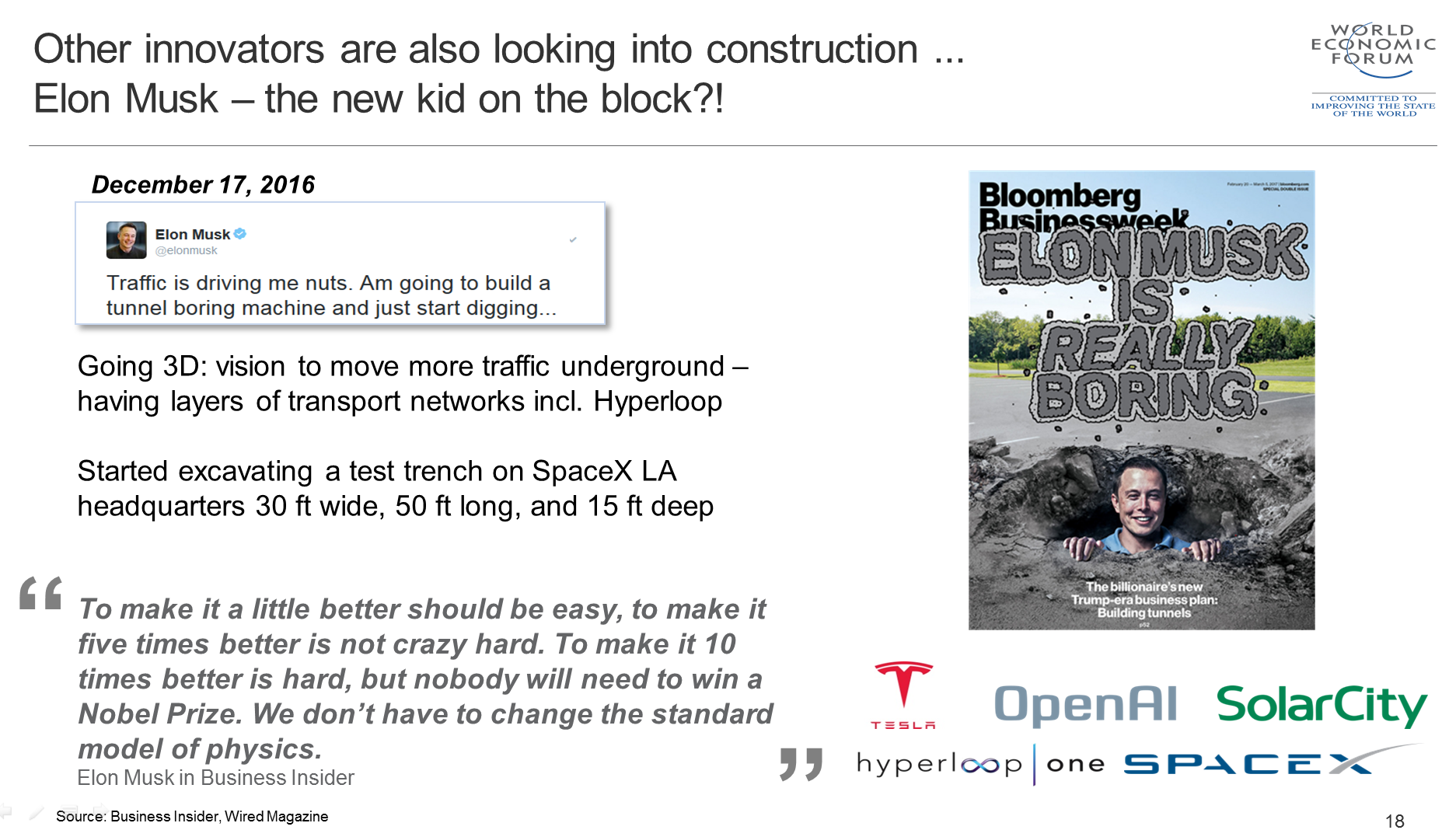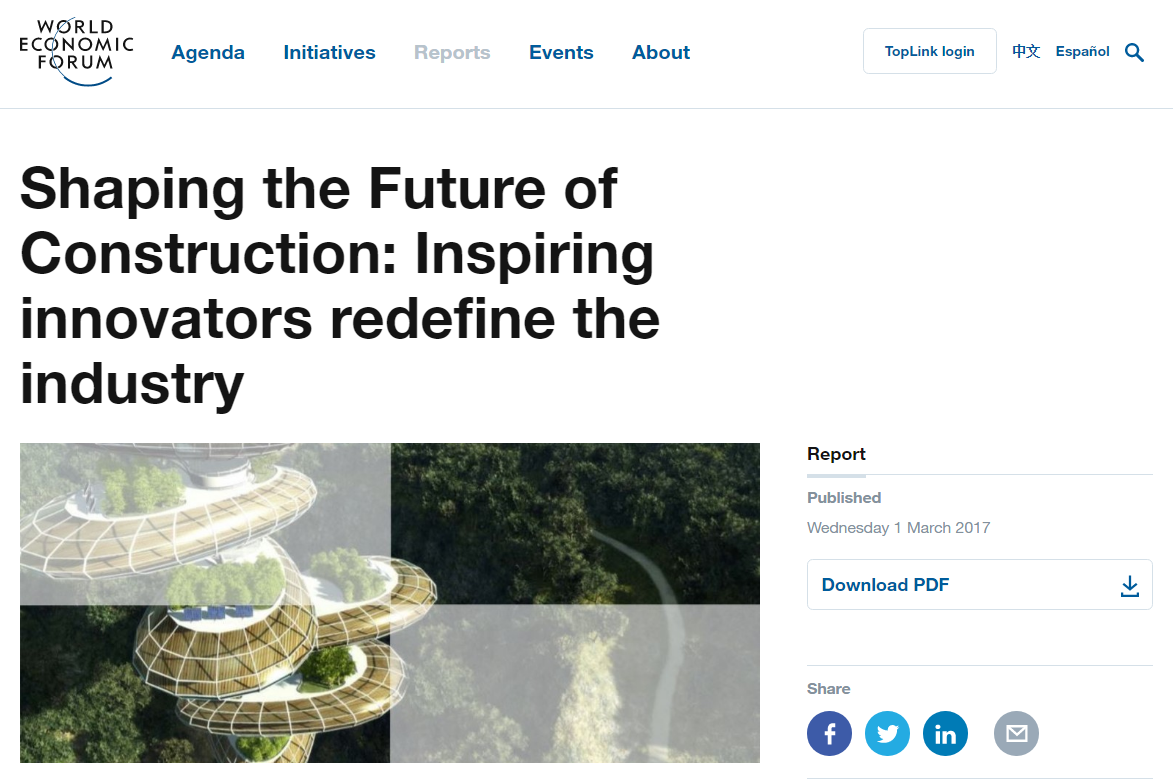Shaping the Future of Construction: Inspiring innovators redefine the industry
Contents |
[edit] Introduction
| "Traffic is driving me nuts. Am going to build a tunnel boring machine and just start digging …” |
Elon Musk’s tweet in December 2016 startled the construction industry. He was not joking: only a month later, he started excavating the first test trench on Space X headquarters in Los Angeles – an incredibly fast move for such a traditionally slow sector.
Thanks to Musk’s visionary and bold approach, he succeeds in attracting the best talent to his projects – a challenge traditional construction companies find hard to meet.
Shaping the Future of Construction: Inspiring innovators redefine the industry, a white paper published by the World Economic Forum and Boston Consulting Group in March 2016, this is just one prominent example of a growing number innovators and disruptive companies shaking up the industry. With 3D-printed houses, automatically designed hospitals, prefabricated skyscrapers – once futuristic dreams are now becoming a reality
[edit] Building the future
Relative to other industries, productivity in construction stalled over the past 50 years. Technology was not making any fundamental advances, and companies remained averse to changing their traditional methods. Recently, however, transformative technological developments have emerged, and some pioneering firms have adopted them for current projects. These developments – 3D printing, building information modelling (BIM), wireless sensing and autonomous equipment, to name just a few – are already starting to turn traditional business models upside down.
Shaping the Future of Construction outlines 10 cases that illustrate the value of embracing innovation. Prominent flagship projects, such as Dubai’s Burj Khalifa, the world’s tallest building, and the Edge in Amsterdam, the world’s most sustainable office building, showcase state-of-the-art innovation.
So, too, do the various pilot projects or start-ups that the report analyses, such as the 3D printing of houses by Chinese company Winsun or the predictive analytics of construction data by Chicago-based Uptake, Forbes’s hottest start-up of 2015 and now valued at over $2 billion. Jointly, their inspirational stories give a glimpse of the industry’s future.
For society, it could be a bright future: construction clients and communities at large will benefit from the long overdue transformation of the industry. And change is urgently needed if we’re going to respond to megatrends such as climate change, migration into urban areas and a new global push for infrastructure.
As a reliable source of entry-level jobs for immigrants and as a provider of affordable housing, the construction industry is sure to be at the centre of public debate. And if public budgets tighten further, the industry’s cost-effectiveness will come under even sharper scrutiny. Incremental change is not an option; innovations in construction could help make a serious difference, both economically and environmentally.
[edit] How construction companies can keep up
So the pace of innovation is accelerating, and that’s a good thing. But companies must act swiftly to keep up and reap the full benefits of these new technologies. Or, to paraphrase sci-fi writer William Gibson, the future of construction is here now – it’s just not evenly distributed. Innovative companies and projects may demonstrate the art of the possible, but what impact will they have on traditional construction? According to Shaping the Future of Construction, there’s a widening gap between the innovation laggards and leaders, in particular with regards to their digital transformation.
So how can companies stimulate innovative ideas, turn them into reality and ultimately succeed in the market? The report offers a few examples from pioneering firms, with lessons such as:
- create an innovation-friendly culture that rewards risk-taking;
- take a longer-term product perspective, rather than thinking in terms of individual projects;
- proactively shape the regulatory environment.
Companies have nothing to gain from delaying. Once they start improving, the benefits – lower costs, shorter delivery times and reduced environmental impact – can begin to accumulate.
But it’s not up to companies alone. Governments are crucial in the transformation of the construction industry. They need to make it easier for regulators, strategic incubators and project owners to adopt new technologies. The report recommends that governments should update building codes, move to forward-looking, performance-based standards, and introduce more flexible procurement models in infrastructure projects to overcome typical hurdles for innovation.
In fact, infrastructure is again high on the agenda in almost all regions of the world. In the words of John Beck, president and CEO of Canada’s Aecon Construction Group: “There has always been a mismatch between the need for infrastructure assets and the capital to fund them. By leveraging all the remarkable innovations that have emerged in recent years, we have a new opportunity to narrow that gap.”
[edit] Shaping the Future of Construction: read the report here
Written by
Michael Buehler, Head of Infrastructure & Urban Development, World Economic Forum
Philipp Gerbert, Senior Partner & Managing Director, The Boston Consulting Group
This article was originally published on the Future of Construction Knowledge Sharing Platform and the WEF Agenda Blog.
[edit] Related articles on Designing Buildings Wiki
- 3D printing.
- 6 buildings that are revolutionising the construction industry.
- A blueprint for the industry from Canada's West Coast.
- Architecture and the need for innovation
- Artificial intelligence and civil engineering.
- Artificial intelligence and surveying.
- Augmented reality in construction.
- Barriers to innovation and Construction 2025
- BIM articles.
- Building information modelling.
- Burj Khalifa.
- CIOB Connect mobile app.
- C-K theory.
- Construction innovation.
- Construction is an industry ripe for tech disruption.
- ConTech.
- Innovation – the key differentiator
- Innovation in construction projects
- Internet of things.
- Predictive analytics.
- Rethinking Construction Innovation and Research: A Review of Government Policies and Practices
- Smart buildings.
- Top 4 challenges facing the construction industry.
- Virtual reality construction experience for students.
- Wearable technology.
--Future of Construction 15:07, 20 Jun 2017 (BST)
Featured articles and news
The UK's Modern Industrial Strategy: A 10 year plan
Previous consultation criticism, current key elements and general support with some persisting reservations.
Building Safety Regulator reforms
New roles, new staff and a new fast track service pave the way for a single construction regulator.
Architectural Technologist CPDs and Communications
CIAT CPD… and how you can do it!
Cooling centres and cool spaces
Managing extreme heat in cities by directing the public to places for heat stress relief and water sources.
Winter gardens: A brief history and warm variations
Extending the season with glass in different forms and terms.
Restoring Great Yarmouth's Winter Gardens
Transforming one of the least sustainable constructions imaginable.
Construction Skills Mission Board launch sector drive
Newly formed government and industry collaboration set strategy for recruiting an additional 100,000 construction workers a year.
New Architects Code comes into effect in September 2025
ARB Architects Code of Conduct and Practice available with ongoing consultation regarding guidance.
Welsh Skills Body (Medr) launches ambitious plan
The new skills body brings together funding and regulation of tertiary education and research for the devolved nation.
Paul Gandy FCIOB announced as next CIOB President
Former Tilbury Douglas CEO takes helm.
UK Infrastructure: A 10 Year Strategy. In brief with reactions
With the National Infrastructure and Service Transformation Authority (NISTA).
Ebenezer Howard: inventor of the garden city. Book review.
The Grenfell Tower fire, eight years on
A time to pause and reflect as Dubai tower block fire reported just before anniversary.
Airtightness Topic Guide BSRIA TG 27/2025
Explaining the basics of airtightness, what it is, why it's important, when it's required and how it's carried out.
Construction contract awards hit lowest point of 2025
Plummeting for second consecutive month, intensifying concerns for housing and infrastructure goals.
Understanding Mental Health in the Built Environment 2025
Examining the state of mental health in construction, shedding light on levels of stress, anxiety and depression.
The benefits of engaging with insulation manufacturers
When considering ground floor constructions.
Lighting Industry endorses Blueprint for Electrification
The Lighting Industry Association fully supports the ECA Blueprint as a timely, urgent call to action.



























